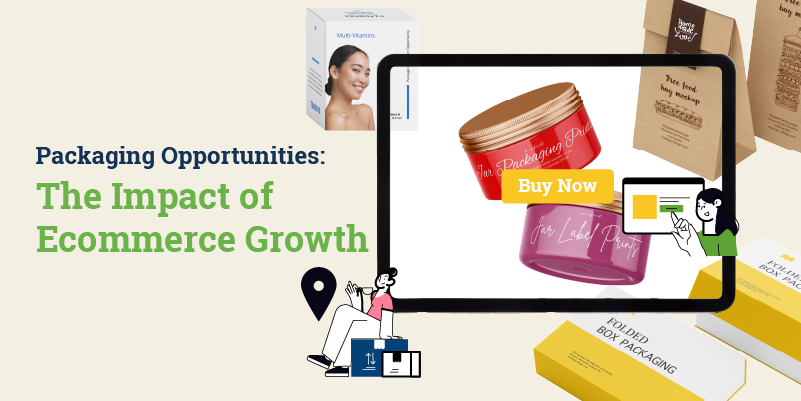Packaging Opportunities: The Impact of Ecommerce Growth
The rise of eCommerce has been remarkable, revolutionizing how consumers shop and businesses operate. Over the past two years, eCommerce sales have grown by 55%, partly driven by the pandemic. Digital marketplaces’ convenience and accessibility have become increasingly enticing to customers worldwide as they continue to flourish.
The booming eCommerce industry has driven a surge in demand for packaging solutions. The increase in online orders calls for efficient, sustainable, and visually appealing packaging options. With this rapid growth, companies must constantly adapt their packaging strategies, design, and practices to keep pace with evolving industry trends.
Packaging is an indispensable bridge between businesses and consumers, going beyond product delivery to shape the customer experience. For eCommerce packaging, it’s the initial physical connection with the brand, leaving a lasting impression on customers’ minds.
This article delves into the multifaceted relationship between eCommerce and packaging. It explores how online sales’ exponential growth influences the industry’s packaging decisions.

The Impact of eCommerce Growth on the Packaging Industry
The exponential growth of eCommerce has unleashed a wave of opportunities and challenges for businesses involved in packaging design and production.
1. The retail eCommerce packaging market will reach $21.4 billion by 2024 from $16.8 billion in 2022.
The substantial growth in the eCommerce packaging market reflects the booming demand for packaging solutions driven by the eCommerce sector. This shift away from retail stores presents companies with ample opportunities to cater to the unique needs of eCommerce.
2. Over 30% of buyers agree that an online product’s packaging changes their perception of the brand.
The immense importance of investing in effective packaging design and presentation cannot be overstated. When customers shop online, they lack the physical interaction they would have in a retail store. As a result, packaging becomes the primary tangible representation of the brand.
3. 66% of consumers are buying more sustainable and sustainably packaged products across all industries.
The growing importance of sustainability in consumer purchasing decisions sends a clear message to businesses. Environmental consciousness is now a significant driver of consumer behavior, making sustainability a mainstream expectation rather than a niche trend. Online sellers must recognize and adapt to this shift to meet customer expectations.
4. The sustainable packaging market will continue growing with a CAGR of 7.2%.
The sustainable packaging market’s compound annual growth rate reflects strong and continuous demand. It’s outpacing the industry’s overall growth rate, showing that the shift towards sustainability is not a passing trend but a fundamental and ongoing transformation, particularly for eCommerce businesses.
5. Plastic packaging waste from the eCommerce sector will reach 4.5 billion pounds (lbs.) by 2025, from 2.1 billion in 2019.
Despite the increasing clamor from consumers, the issue of plastic packaging waste in eCommerce remains significant. However, online retailers have a chance to take the lead in adopting sustainable packaging practices and differentiate themselves from competitors.
Retail Packaging vs eCommerce Packaging: What’s the Difference?
Traditional retail packaging has long catered to in-store displays and shelf presentations, but the landscape shifts dramatically in eCommerce.
Design and visual appeal
In physical retail, packaging design aims to capture consumers’ attention amid a sea of competing products on store shelves. Vibrant colors, eye-catching graphics, and striking visuals are often utilized to stand out and entice shoppers to explore the products further.
On the other hand, eCommerce packaging serves different objectives. It prioritizes product protection during transit and creates a memorable unboxing experience while maintaining visual appeal.
Size and dimensions
Retail packaging designs face constraints from standardized shelf sizes and display requirements. Brands must adhere to specific dimensions to ensure their products fit seamlessly within these spaces, leading to uniformly shaped packages.
Unlike retail packaging, eCommerce packaging benefits from unparalleled size and dimension flexibility. Without the constraints of physical shelves, eCommerce businesses can tailor packaging to their product’s size and shape.
It enables them to optimize space utilization, minimize material waste, and create functional and efficient packaging for shipping and storage.
Handling and transit
Retail packaging faces the challenge of withstanding the rigors of in-store handling by customers and store employees. Because stores display them on shelves, the products must maintain visual appeal and structural integrity after frequent interactions with potential buyers.
eCommerce packaging must prioritize superior product protection during shipping and handling in transit. As packages go through various stages of transportation and sorting, they are subject to potential rough handling, stacking, and exposure to varying weather conditions.
Cost and sustainability
In retail packaging, the need for bulk production to stock physical stores often leads businesses to prioritize cost-effectiveness over sustainability. Retail packaging typically relies on inexpensive but less eco-friendly materials to meet the demands of multiple store locations.
In eCommerce, a more direct connection between seller and consumer enables a streamlined supply chain, shipping products directly to customers’ homes. This efficiency allows businesses to explore lightweight and sustainable packaging materials without high costs, making eco-friendly solutions more accessible.
Information and labels
Retail packaging faces the challenge of fitting all branding and product information directly onto the packaging with limited available space. It must convey essential details, such as product name, usage instructions, ingredients, safety warnings, and regulatory information, in a self-sufficient manner.
Conversely, eCommerce packaging can adopt a more minimalistic approach to labeling. Online sellers provide the required information on the packaging but often rely on their digital platforms, such as product listings or websites, to deliver comprehensive details about the product.
eCommerce Growth and Packaging: Opportunities and Strategies
For successful eCommerce companies, the moment customers receive the package is important. It marks the first tangible interaction with the brand, making it a critical moment in the brand-consumer relationship. Here are some practical strategies to maximize the impact of this first interaction:
1. Create functional packaging
Packaging is part of the eCommerce experience. Businesses should prioritize designs that not only protect the product but also enhance the unboxing journey for customers.
The goal is to make customers feel like they’re opening a present when they receive your product. To provide added value to customers, consider incorporating practical elements, such as easy storage solutions or reusability.
When partnering with a product packaging manufacturer, ensure they effectively fulfill your eCommerce packaging needs. They should have experience with packaging types such as frustration-free packaging, a common preference for online consumers.
2. Leverage eCommerce’s enhanced flexibility
The absence of physical store shelf constraints opens new creative horizons for eCommerce packaging. Businesses can explore innovative and imaginative designs that captivate consumers during unboxing. This enhanced flexibility allows customized packaging solutions for individual products, improving the overall customer experience.
When selecting a packaging partner, one must consider their expertise and constructive input during the design phase. Look for a partner with robust quality control processes and the ability to conduct tests and make structural changes when necessary. Ensure they align with your brand’s goals while maintaining practicality for large-scale manufacturing.
3. Optimize for brand identity
Due to limited direct customer interactions, packaging becomes a powerful tool for reinforcing brand identity. By designing packaging that aligns with a brand’s values, aesthetics, and messaging, businesses can create a cohesive and unified brand experience. This emotional resonance with customers leads to strengthened brand loyalty and lasting connections.
4. Incorporate customization options
Personalization is gaining popularity in eCommerce, and packages offer an excellent opportunity to deliver unique experiences. By providing customization options such as custom labels and packaging inserts, businesses can create a sense of exclusivity, fostering a stronger customer connection.
5. Switch to sustainable packaging
Numerous sustainable packaging alternatives offer equivalent protection to traditional materials. For example, a 3M Scotch Cushion Lock can replace packaging peanuts and air cushions. Conduct tests on potential options to find a balance between protection and eco-friendliness.
Benefits of Effective eCommerce Packaging
The biggest challenge in packaging is balancing using lighter-weight materials, minimizing space, ensuring product protection, and representing the brand well. When a business achieves an effective eCommerce packaging design that incorporates these factors, they enjoy a plethora of benefits, including:
1. Increased customer satisfaction and loyalty
Visual appealing, functional, and customer-centric packaging turns a simple container into a memorable and delightful experience. Effective packaging design enhances the customer experience, increasing customer satisfaction and loyalty.
2. Enhanced brand perception and differentiation
Packaging design is an essential piece in building brand recognition and customer loyalty. Generic, off-the-shelf packaging can make a product feel cheaper and lower quality, regardless of the product’s actual materials and design.
Businesses must prioritize thoughtful and distinctive packaging that resonates with their target audience to create an authentic, high-quality, and unique brand image.
3. Expanded engagement and word-of-mouth marketing
Appealing packaging can turn into shareable moments on social media. Delighted customers are likelier to share their unboxing experiences with friends and followers, creating user-generated content that acts as organic marketing. This word-of-mouth approach can significantly expand a brand’s reach at a minimal cost.
4. Reduced shipping costs and waste
Good eCommerce packaging prioritizes efficiency, minimizing wasted space and materials to reduce shipping costs and environmental impact. Emphasizing eco-friendly packaging also boosts sustainability efforts and enhances a brand’s reputation among conscious consumers.
5. Improved product protection
Finally, well-designed packages provide robust protection for products during transit, reducing the risk of damage and returns and ensuring customers receive their purchases in pristine condition. This level of care fosters trust and confidence in online sellers, creating a positive customer experience.
Unwrap Excellence with Thoughtful eCommerce Packaging
eCommerce packaging emerges as a powerful vehicle for businesses to seize abundant opportunities. However, online retailers must align their packaging strategies with the industry’s demands and the call for sustainability to unlock their packaging’s full potential.
Effective eCommerce packaging offers a multitude of benefits. It enhances customer satisfaction, loyalty, and brand perception, increasing social media engagement and word-of-mouth marketing. Finally, embracing eco-friendly practices reduces costs and packaging waste, reinforcing a brand’s commitment to environmental stewardship.
As the leading packaging solutions provider, Meyers elevates your brand with innovative and sustainable packaging ideas that reflect your unique identity. Whether you want to optimize your eCommerce packaging or create eye-catching influencer kits, our experts are here to bring your retail product packaging to the next level. Contact us today!

About Michael Dillon
Michael is a futurist, technologist, and self-proclaimed sustainability nerd who specializes in creating scalable revenue growth engines. He spent the first 11 years of his career at tech startups. Each of those startups worked to create a better future by addressing societal challenges ranging from increasing healthcare costs to the proliferation of counterfeit medicines.
Before joining Meyers, Michael co-founded Vugo, which aims to create free transportation by leveraging a novel revenue-generating mobility media platform. Michael was tapped to revamp Meyers’ marketing department in the spring of 2020, then named as Chief Revenue Officer in January of 2022. Michael loves writing about environmental challenges and opportunities, sustainability, sustainable packaging, business strategy, and business leadership.![]()

